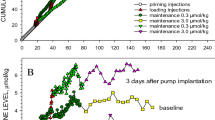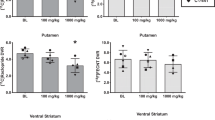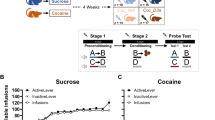Abstract
The rapid delivery of drugs of abuse to the brain is associated with an increased likelihood and severity of addiction. Here we evaluated the hypothesis that rapidly delivered cocaine facilitates the addiction process by promoting the development of enhanced motivation for the drug. Rats lever-pressed for cocaine delivered intravenously over 5 or 90 s under fixed ratio (FR) during 6-h sessions. The motivation for cocaine was subsequently assessed using a progressive ratio (PR) schedule, where each successive drug injection cost an exponentially greater number of lever presses, until the cessation of responding. Throughout all self-administration sessions, all rats could only take one injection every 90 s. The 5-s groups self-administered more drug than the 90-s groups across the FR sessions. Under PR, animals that had chronically self-administered rapidly delivered cocaine took more cocaine across a range of doses and regardless of whether the drug was delivered over 5 or 90 s during PR testing. The speed of delivery also determined the long-term neurobiological impact of cocaine. Fourteen days following cocaine withdrawal, caudate-putamen D2 levels were decreased only in the 90-s rats, and quinpirole-mediated Gαi/o-protein activation was increased to a greater extent in the 90- vs 5-s rats. Thus, rapid delivery promotes the pursuit of cocaine in the face of rising costs and alters cocaine-induced changes in striatal D2 receptor number and function. As such, rapidly delivered cocaine might facilitate addiction because it more readily alters brain motivation circuits in ways that contribute to the compulsive pursuit of the drug.
Similar content being viewed by others
Log in or create a free account to read this content
Gain free access to this article, as well as selected content from this journal and more on nature.com
or
References
Abreu ME, Bigelow GE, Fleisher L, Walsh SL (2001). Effect of intravenous injection speed on responses to cocaine and hydromorphone in humans. Psychopharmacology (Berl) 154: 76–84.
Ahmed SH (2012). The science of making drug-addicted animals. Neuroscience 211: 107–125.
Ahmed SH, Kenny PJ, Koob GF, Markou A (2002). Neurobiological evidence for hedonic allostasis associated with escalating cocaine use. Nat Neurosci 5: 625–626.
Ahmed SH, Koob GF (1998). Transition from moderate to excessive drug intake: change in hedonic set point. Science 282: 298–300.
Badiani A, Robinson TE (2004). Drug-induced neurobehavioral plasticity: the role of environmental context. Behav Pharmacol 15: 327–339.
Balster RL, Schuster CR (1973). Fixed-interval schedule of cocaine reinforcement: effect of dose and infusion duration. J Exp Anal Behav 20: 119–129.
Barrio G, De La Fuente L, Lew C, Royuela L, Bravo MJ, Torrens M (2001). Differences in severity of heroin dependence by route of administration: the importance of length of heroin use. Drug Alcohol Depend 63: 169–177.
Belin D, Balado E, Piazza PV, Deroche-Gamonet V (2009). Pattern of intake and drug craving predict the development of cocaine addiction-like behavior in rats. Biol Psychiatry 65: 863–868.
Briand LA, Flagel SB, Seeman P, Robinson TE (2008). Cocaine self-administration produces a persistent increase in dopamine D2 high receptors. Eur Neuropsychopharmacol 18: 551–556.
Brown PL, Kiyatkin EA (2005). Brain temperature change and movement activation induced by intravenous cocaine delivered at various injection speeds in rats. Psychopharmacology (Berl) 181: 299–308.
Carpenter MJ, Chutuape MA, Stitzer ML (1998). Heroin snorters vs injectors: comparison on drug use and treatment outcome in age-matched samples. Drug Alcohol Depend 53: 11–15.
Crombag HS, Ferrario CR, Robinson TE (2008). The rate of intravenous cocaine or amphetamine delivery does not influence drug-taking and drug-seeking behavior in rats. Pharmacol Biochem Behav 90: 797–804.
de Wit H, Dudish S, Ambre J (1993). Subjective and behavioral effects of diazepam depend on its rate of onset. Psychopharmacology (Berl) 112: 324–330.
Deroche-Gamonet V, Belin D, Piazza PV (2004). Evidence for addiction-like behavior in the rat. Science 305: 1014–1017.
Ferrario CR, Robinson TE (2007). Amphetamine pretreatment accelerates the subsequent escalation of cocaine self-administration behavior. Eur Neuropsychopharmacol 17: 352–357.
Ferrario CR, Shou M, Samaha AN, Watson CJ, Kennedy RT, Robinson TE (2008). The rate of intravenous cocaine administration alters c-fos mRNA expression and the temporal dynamics of dopamine, but not glutamate, overflow in the striatum. Brain Res 1209: 151–156.
Ferri CP, Gossop M (1999). Route of cocaine administration: patterns of use and problems among a Brazilian sample. Addict Behav 24: 815–821.
Frankowska M, Marcellino D, Adamczyk P, Filip M, Fuxe K (2013). Effects of cocaine self-administration and extinction on D2 -like and A2A receptor recognition and D2 -like/Gi protein coupling in rat striatum. Addiction biology 18: 455–466.
Gossop M, Griffiths P, Powis B, Strang J (1992). Severity of dependence and route of administration of heroin, cocaine and amphetamines. Br J Addict 87: 1527–1536.
Haney M, Foltin RW, Fischman MW (1998). Effects of pergolide on intravenous cocaine self-administration in men and women. Psychopharmacology (Berl) 137: 15–24.
Hatsukami DK, Fischman MW (1996). Crack cocaine and cocaine hydrochloride. Are the differences myth or reality? JAMA 276: 1580–1588.
Hughes JR (1989). Dependence potential and abuse liability of nicotine replacement therapies. Biomed Pharmacother 43: 11–17.
Kalivas PW, Volkow ND (2005). The neural basis of addiction: a pathology of motivation and choice. Am J Psychiatry 162: 1403–1413.
Kato S, Wakasa Y, Yanagita T (1987). Relationship between minimum reinforcing doses and injection speed in cocaine and pentobarbital self-administration in crab-eating monkeys. Pharmacol Biochem Behav 28: 407–410.
Kippin TE, Fuchs RA, See RE (2006). Contributions of prolonged contingent and noncontingent cocaine exposure to enhanced reinstatement of cocaine seeking in rats. Psychopharmacology (Berl) 187: 60–67.
Kollins SH, Rush CR, Pazzaglia PJ, Ali JA (1998). Comparison of acute behavioral effects of sustained-release and immediate-release methylphenidate. Exp Clin Psychopharmacol 6: 367–374.
Le Moal M (2009). Drug abuse: vulnerability and transition to addiction. Pharmacopsychiatry 42 (Suppl 1): S42–S55.
Li D, Depoortere R, Emmett-Oglesby M (1994). Tolerance to the reinforcing effects of cocaine in a progressive ratio paradigm. Psychopharmacology 116: 326–332.
Liu Y, Roberts DC, Morgan D (2005). Sensitization of the reinforcing effects of self-administered cocaine in rats: effects of dose and intravenous injection speed. Eur J Neurosci 22: 195–200.
Maheux J, St-Hilaire M, Voyer D, Tirotta E, Borrelli E, Rouillard C et al (2012). Dopamine D(2) antagonist-induced striatal Nur77 expression requires activation of mGlu5 receptors by cortical afferents. Front Pharmacol 3: 153.
Mantsch JR, Ho A, Schlussman SD, Kreek MJ (2001). Predictable individual differences in the initiation of cocaine self-administration by rats under extended-access conditions are dose-dependent. Psychopharmacology (Berl) 157: 31–39.
Mantsch JR, Yuferov V, Mathieu-Kia AM, Ho A, Kreek MJ (2004). Effects of extended access to high vs low cocaine doses on self-administration, cocaine-induced reinstatement and brain mRNA levels in rats. Psychopharmacology (Berl) 175: 26–36.
Martinez D, Broft A, Foltin RW, Slifstein M, Hwang DR, Huang Y et al (2004). Cocaine dependence and d2 receptor availability in the functional subdivisions of the striatum: relationship with cocaine-seeking behavior. Neuropsychopharmacology 29: 1190–1202.
Morgan D, Liu Y, Roberts DC (2006). Rapid and persistent sensitization to the reinforcing effects of cocaine. Neuropsychopharmacology 31: 121–128.
Nicolaysen LC, Pan H-T, Justice JB Jr (1988). Extracellular cocaine and dopamine concentrations are linearly related in rat striatum. Brain Res 456: 317–323.
O'Brien CP (2008). Review. Evidence-based treatments of addiction. Philos Trans R Soc Lond B Biol Sci 363: 3277–3286.
Panlilio LV, Goldberg SR, Gilman JP, Jufer R, Cone EJ, Schindler CW (1998). Effects of delivery rate and non-contingent infusion of cocaine on cocaine self-administration in rhesus monkeys. Psychopharmacology (Berl) 137: 253–258.
Panlilio LV, Weiss SJ, Schindler CW (1996). Cocaine self-administration increased by compounding discriminative stimuli. Psychopharmacology (Berl) 125: 202–208.
Paterson NE, Markou A (2003). Increased motivation for self-administered cocaine after escalated cocaine intake. Neuroreport 14: 2229–2232.
Paxinos G, Watson C (1986) The rat brain in stereotaxic coordinates 2nd edn. Academic: New York, NY, USA.
Pickens R, Dougherty J, Thompson T (1969). Effects of volume and duration of infusion on cocaine reinforcement with concurrent activity recording. In: NAS-NRC (ed) Minutes of the Meeting of the Committee on Problems of Drug Dependence. Washington, DC, USA. pp 5805–5811.
Rawson RA, Gonzales R, Marinelli-Casey P, Ang A (2007). Methamphetamine dependence: a closer look at treatment response and clinical characteristics associated with route of administration in outpatient treatment. Am J Addict 16: 291–299.
Richardson NR, Roberts DC (1996). Progressive ratio schedules in drug self-administration studies in rats: a method to evaluate reinforcing efficacy. J Neurosci Methods 66: 1–11.
Roberts DC, Loh EA, Vickers G (1989). Self-administration of cocaine on a progressive ratio schedule in rats: dose-response relationship and effect of haloperidol pretreatment. Psychopharmacology (Berl) 97: 535–538.
Roberts DC, Morgan D, Liu Y (2007). How to make a rat addicted to cocaine. Prog Neuropsychopharmacol Biol Psychiatry 31: 1614–1624.
Robinson TE, Berridge KC (1993). The neural basis of drug craving: an incentive-sensitization theory of addiction. Brain Res Brain Res Rev 18: 247–291.
Samaha AN, Li Y, Robinson TE (2002). The rate of intravenous cocaine administration determines susceptibility to sensitization. J Neurosci 22: 3244–3250.
Samaha AN, Mallet N, Ferguson SM, Gonon F, Robinson TE (2004). The rate of cocaine administration alters gene regulation and behavioral plasticity: implications for addiction. J Neurosci 24: 6362–6370.
Samaha AN, Minogianis EA, Nachar W (2011). Cues paired with either rapid or slower self-administered cocaine injections acquire similar conditioned rewarding properties. PLoS One 6: e26481.
Samaha AN, Robinson TE (2005). Why does the rapid delivery of drugs to the brain promote addiction? Trends Pharmacol Sci 26: 82–87.
Schindler CW, Cogan ES, Thorndike EB, Panlilio LV (2011). Rapid delivery of cocaine facilitates acquisition of self-administration in rats: An effect masked by paired stimuli. Pharmacol Biochem Behav 99: 301–306.
Schindler CW, Panlilio LV, Thorndike EB (2009). Effect of rate of delivery of intravenous cocaine on self-administration in rats. Pharmacol Biochem Behav 93: 375–381.
Self DW, Barnhart WJ, Lehman DA, Nestler EJ (1996). Opposite modulation of cocaine-seeking behavior by D1- and D2-like dopamine receptor agonists. Science 271: 1586–1589.
Sim LJ, Selley DE, Childers SR (1995). In vitro autoradiography of receptor-activated G proteins in rat brain by agonist-stimulated guanylyl 5'-[gamma-[35S]thio]-triphosphate binding. Proc Natl Acad Sci USA 92: 7242–7246.
Sorge RE, Clarke PB (2009). Rats self-administer intravenous nicotine delivered in a novel smoking-relevant procedure: effects of dopamine antagonists. J Pharmacol Exp Ther 330: 633–640.
Sovago J, Makkai B, Gulyas B, Hall H (2005). Autoradiographic mapping of dopamine-D2/D3 receptor stimulated [35S]GTPgammaS binding in the human brain. Eur J Neurosci 22: 65–71.
Tournier BB, Steimer T, Millet P, Moulin-Sallanon M, Vallet P, Ibanez V et al (2013). Innately low D2 receptor availability is associated with high novelty-seeking and enhanced behavioural sensitization to amphetamine. Int J Neuropsychopharmacol (e-pub ahead of print).
Ujike H, Akiyama K, Otsuki S (1990). D-2 but not D-1 dopamine agonists produce augmented behavioral response in rats after subchronic treatment with methamphetamine or cocaine. Psychopharmacology (Berl) 102: 459–464.
Vanderschuren LJ, Everitt BJ (2004). Drug seeking becomes compulsive after prolonged cocaine self-administration. Science 305: 1017–1019.
Volkow ND, Fowler JS, Wang GJ, Hitzemann R, Logan J, Schlyer DJ et al (1993). Decreased dopamine D2 receptor availability is associated with reduced frontal metabolism in cocaine abusers. Synapse 14: 169–177.
Volkow ND, Fowler JS, Wolf AP, Schlyer D, Shiue CY, Alpert R et al (1990). Effects of chronic cocaine abuse on postsynaptic dopamine receptors. Am J Psychiatry 147: 719–724.
Volkow ND, Wang GJ, Fowler JS, Logan J, Gatley SJ, Gifford A et al (1999). Prediction of reinforcing responses to psychostimulants in humans by brain dopamine D2 receptor levels. Am J Psychiatry 156: 1440–1443.
Wakabayashi KT, Weiss MJ, Pickup KN, Robinson TE (2010). Rats markedly escalate their intake and show a persistent susceptibility to reinstatement only when cocaine is injected rapidly. J Neurosci 30: 11346–11355.
Wakasa Y, Takada K, Yanagita T (1995). Reinforcing effect as a function of infusion speed in intravenous self-administration of nicotine in rhesus monkeys. Nihon Shinkei Seishin Yakurigaku Zasshi 15: 53–59.
Wee S, Mandyam CD, Lekic DM, Koob GF (2008). Alpha 1-noradrenergic system role in increased motivation for cocaine intake in rats with prolonged access. Eur Neuropsychopharmacol 18: 303–311.
Wee S, Specio SE, Koob GF (2007). Effects of dose and session duration on cocaine self-administration in rats. J Pharmacol Exp Ther 320: 1134–1143.
Winger G, Hofmann GG, Woods JH (1992) A Handbook on Drug and Alcohol Abuse: the Biomedical Aspects. Oxford UP: New York, NY, USA.
Woolverton WL, Wang Z (2004). Relationship between injection duration, transporter occupancy and reinforcing strength of cocaine. Eur J Pharmacol 486: 251–257.
Acknowledgements
We thank Miss Anne-Marie Bédard, Mr Karim Bouayad-Gervais and Miss Irina Gheoda for valuable technical assistance. We are grateful to Dr Guy Rousseau for advice on statistical analysis of the data.
Author information
Authors and Affiliations
Corresponding author
Additional information
Supplementary Information accompanies the paper on the Neuropsychopharmacology website
Supplementary information
Rights and permissions
About this article
Cite this article
Minogianis, EA., Lévesque, D. & Samaha, AN. The Speed of Cocaine Delivery Determines the Subsequent Motivation to Self-Administer the Drug. Neuropsychopharmacol 38, 2644–2656 (2013). https://doi.org/10.1038/npp.2013.173
Received:
Revised:
Accepted:
Published:
Issue date:
DOI: https://doi.org/10.1038/npp.2013.173
Keywords
This article is cited by
-
Intermittent intake of rapid cocaine injections promotes the risk of relapse and increases mesocorticolimbic BDNF levels during abstinence
Neuropsychopharmacology (2019)
-
High and escalating levels of cocaine intake are dissociable from subsequent incentive motivation for the drug in rats
Psychopharmacology (2018)
-
The self-administration of rapidly delivered cocaine promotes increased motivation to take the drug: contributions of prior levels of operant responding and cocaine intake
Psychopharmacology (2014)



